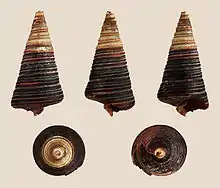Telescopium telescopium
Telescopium telescopium, or horn snail, is a species of marine gastropod molluscs in the family Potamididae.[1] It is found in mangrove forests throughout the coastlines of the Indian Ocean.
| Telescopium telescopium | |
|---|---|
 | |
| Five views of a shell of Telescopium telescopium | |
| Scientific classification | |
| Kingdom: | |
| Phylum: | |
| Class: | |
| (unranked): | |
| Superfamily: | |
| Family: | |
| Genus: | |
| Species: | T. telescopium |
| Binomial name | |
| Telescopium telescopium | |
| Synonyms[1] | |
Description
This large snail has an 8–15 cm tall, conical shell strongly reminiscent of an ice cream cone. T. telescopium is commonly seen in Southeast Asian mangroves, on mud, sometimes in the hundreds covering a large area. It is also called rodong or berongan in Malay.
The largest of horn snails, the heavy conical shell is actually beautifully marked but the patterns are usually hidden by mud and other encrusting animals. The outer lip is thin and not flared. Operculum small and circular. The animal is velvety black with a highly extendible proboscis. There is a third eye on its mantle margin, in addition to a pair of eyes at the tentacles. It can stay out of water for long periods of time.
Telescopium feeds on detritus and algae from the mud surface at low tide by sucking using its proboscis.
Human relevance
This species is gathered for food in Southeast Asia and is often sold in traditional markets. It is steamed and eaten with chili.
Distribution
- Australia - northern mangroves
- Madagascar[1]
- Pakistan
- Philippines
- Sri Lanka
- India
- Bangladesh
- Myanmar
- Malaysia
- Indonesia
References
- Telescopium telescopium (Linnaeus, 1758). Retrieved through: World Register of Marine Species on 17 May 2010.
- Reid, D.G., Dyal, P., Lozouet, P., Glaubrecht, M. & Williams, S.T. (2008) Mudwhelks and mangroves: the evolutionary history of an ecological association (Gastropoda: Potamididae). Molecular Phylogenetics and Evolution 47: 680–699
External links
- Datta U., Hembram M. L., Roy S. & Mukherjee P. (2009). "Natural Biomolecules from Marine Snail Telescopium telescopium and structure of its sperm: A Phylogenetic Study". Nature Precedings <http://hdl.handle.net/10101/npre.2009.3386.1>